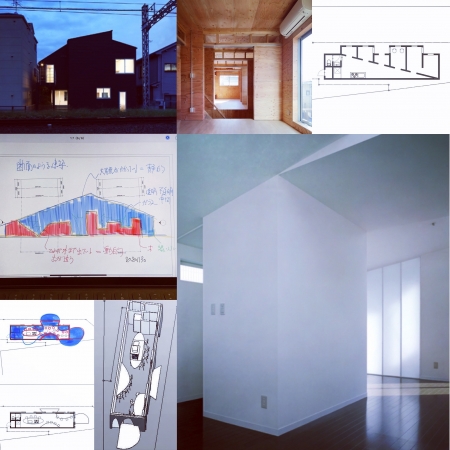消費からストックへ
感情や気持ちに居場所を与えるようなことを考えている。建築があって物としては成立し、それで過不足なく、人と建築の関係性から人を中心に考えることでも建築は成立し、それでも過不足はない。
もっと細分化して物としての建築にも素材から考えるのか、形から考えるのか、さらに表層の仕上げに特化するのか、あと見え方も物の範疇になる。
人を中心にすれば、建築は物本来の在り方を変えて人に内在する尺度で考えられる。例えば、ただそこにある建築に対して「美しい建築」と人の判断が加われば、その判断を前提に建築を考えはじめることになり、もはやただそこにある建築ではなくなるというように、人がいることで建築の在り方が決まっていく。
感情や気持ちは人が抱くものであるから、人を中心に考えて判断していく建築の在り方の範疇になるが、人の思考は感情や気持ちに左右されるので、思考より先に抱く感情や気持ちだけを先に露わにして取り出すことは可能だと考え、感情や気持ちだけを独立させて、感情や気持ちが建築と直接関係性を築くような居場所を与えてやることができれば、より建築が身近な存在になり、建築という物が消費される財からストックされる財に変わっていくキッカケにならないかと考えている。
"From consumption to stock"
I'm thinking of giving a place to my emotions and feelings. There is architecture and it is established as a thing, so there is no excess or deficiency, and architecture is established by thinking mainly about people from the relationship between people and architecture, but there is still no excess or deficiency.
Whether to think more subdivided into architecture as a thing from the material, from the shape, or to specialize in the finishing of the surface layer, the appearance also falls into the category of things.
If we focus on people, architecture can be thought of as a scale that is inherent in people by changing the way things are originally. For example, if a person's judgment is added to the architecture that is there, it will start to think about the architecture based on that judgment, and there are people who are no longer just the architecture that is there. This will determine the way architecture should be.
Since emotions and feelings are things that people have, they fall into the category of architecture that thinks and makes decisions centered on people, but since people's thoughts are influenced by emotions and feelings, emotions that they hold before thinking. I think that it is possible to expose only the feelings and feelings first, and if it is possible to make only the feelings and feelings independent and give a place where the feelings and feelings have a direct relationship with architecture, it will be better. I am wondering if architecture will become a familiar presence, and it will be a chance for architecture to change from consumed goods to stocked goods.


